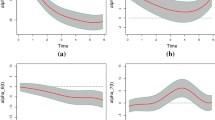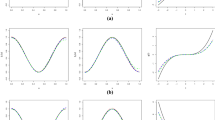Abstract
We consider varying coefficient models which are an extension of the classical linear regression models in the sense that the regression coefficients are replaced by functions in certain variables (often time). Varying coefficient models have been popular in longitudinal data and panel data studies, and have been applied in fields, such as finance and health sciences. We estimate the coefficient functions by splines. An important question in a varying coefficient model is whether a coefficient function is monotone or convex. We develop consistent testing procedures for monotonicity and convexity. Moreover, we provide procedures to test simultaneously the shapes of certain coefficient functions in a varying coefficient model. The tests use constrained and unconstrained regression splines. The performances of the proposed tests are illustrated on simulated data. We also give a real data application.


Similar content being viewed by others
Notes
The code is available from https://www.dropbox.com/sh/dwdhuz7e6j459eu/AAAQ7lkBocy7ACM8bw8eHSkOa?dl=0.
References
Antoniadis A, Gijbels I, Verhasselt A (2012) Variable selection in varying coefficient models using P-splines. J Comput Graph Stat 21(3):638–661
Bowman AW, Jones MC, Gijbels I (1998) Testing monotonicity of regression. J Comput Graph Stat 7(4):489–500
de Boor C (2001) A practical guide to splines. Number v. 27. in Applied Mathematical Sciences. Springer, New York
Diggle PJ (1988) An approach to the analysis of repeated measurements. Biometrics 44(4):959–971
Diggle P, Verbyla A (1998) Non-parametric estimation of covariance structure in longitudinal data. Biometrics 54:401–415
Fan J, Wenyang Z (2008) Statistical methods with varying coefficient models. Stat Interface 1(1):179–195
Fan J, Zhang W (1999) Statistical estimation in varying coefficient models. Ann Stat 27(5):1491–1518
Ghosal S, Sen A, van der Vaart AW (2000) Testing monotonicity of regression. Ann Stat 28(4):1054–1082
Hastie T, Tibshirani R (1993) Varying-coefficient models. J R Stat Soc Ser B (Methodol) 55(4):757–796
Hedeker D, Gibbons RD (1997) Application of random-effects pattern-mixture models for missing data in longitudinal studies. Psychol Methods 2(6):64–78
Hoover DR, Rice JA, Wu CO, Yang L-P (1998) Nonparametric smoothing estimates of time-varying coefficient models with longitudinal data. Biometrika 85(4):809–822
Huang JZ, Wu CO, Zhou L (2002) Varying-coefficient models and basis function approximations for the analysis of repeated measurements. Biometrika 89(1):111–128
Huang JZ, Wu CO, Zhou L (2004) Polynomial spline estimation and inference for varying coefficient models with longitudinal data. Stat Sin 14(3):763–788
Lorr M, Klett CJ (1966) Inpatient multidimensional psychiatric scale: manual. Consulting Psychologists Press, Palo Alto, CA
Schumaker L (2007) Spline functions: basic theory. Cambridge University Press, Cambridge
Silvapulle MJ, Sen PK (2005) Constrained statistical inference: order, inequality, and shape constraints. Wiley, New York
Wang JC, Meyer MC (2011) Testing the monotonicity or convexity of a function using regression splines. Can J Stat 39:89–107
Zhang H-G, Mei C-L (2012) Sizer inference for varying coefficient models. Commun Stat Simul Comput 41(10):1944–1959
Zhang H-G, Mei C-L, Wang H-L (2013) Robust sizer approach for varying coefficient models. Math Probl Eng 2013:13 (Article ID: 547874)
Acknowledgements
We would like to thank the Editor, an Associate Editor, and the referees for their detailed reading and very valuable comments on the manuscript. M. Ahkim’s research was supported by the Special Research Fund (BOF) of Universiteit Antwerpen (Grant Number 42FA070300FFB5994). A. Verhasselt and I. Gijbels gratefully acknowledge support from the IAP Research Network P7/06 of the Belgian State (Belgian Science Policy). I. Gijbels acknowledges support from the KU Leuven Research Council (GOA/12/014). The infrastructure of the VSC—Flemish Supercomputer Center, funded by the Hercules Foundation and the Flemish Government—department EWI, was used for the simulations.
Author information
Authors and Affiliations
Corresponding author
Electronic supplementary material
Below is the link to the electronic supplementary material.
Appendices
Appendix A: Notation
In this paper, two submultiplicative matrix norms are considered. For a real matrix \(\mathbf {A}\in \mathbb {R}^{n_1 \times n_2}\), \(\Vert \mathbf {A}\Vert _2\) denotes the Frobenius norm: \(\Vert \mathbf {A}\Vert _2=\sqrt{\sum _{i=1}^{n_1}\sum _{j=1}^{n_2}\mathbf {A}_{ij}^2}\). The norm \(\Vert \cdot \Vert _\infty \) is defined by \(\Vert \mathbf {A}\Vert _\infty =\max _{i=1,\ldots ,n_1}\sum _{j=1}^{n_2}|\mathbf {A}_{ij}|\). Furthermore, we use the notation
Appendix B: Assumptions
Assumptions:
-
1.
The observation times \(t_{ij},\ j = 1, \ldots , N_i,\ i = 1, \ldots , n,\) are chosen independently according to a distribution function \(F_T(t)\) on \(\mathcal {T}\). Moreover, they are independent of the response and the covariate process \(\{(Y_i (t ),X_{i1}(t),\ldots , X_{id}(t))\},\ i = 1, \ldots , n\). The distribution function \(F_T(t)\) has a Lebesgue density \(f_T(t)\) that is bounded away from zero and infinity, uniformly over all \(t \in \mathcal {T}\), that is, there exist positive constants \(M_1\) and \(M_2\), such that \(M_1 \leqslant f_T (t)\leqslant M_2\) for all \(t \in \mathcal {T}\).
-
2.
The eigenvalues \(\eta _0(t ), \ldots , \eta _d (t)\) of \({\varvec{\Sigma }}(t) = E(\mathbf {X}(t)\mathbf {X}(t)^\top )\) are bounded away from zero and infinity, uniformly over all \(t \in \mathcal {T}\), that is, there exist positive constants \(M_3\) and \(M_4\), such that \(M_3\leqslant \eta _0(t)\leqslant \ldots \leqslant \eta _d(t)\leqslant M_4\) for all \(t \in \mathcal {T}\).
-
3.
There exists a positive constant \(M_5\), such that \(|X_p(t)| \leqslant M_5\) for all \(t \in \mathcal {T}\) and \(p=0, \ldots ,d\).
-
4.
There exists a positive constant \(M_6\), such that \(E(\varepsilon ^2(t))\leqslant M_6 < \infty \) for all \(t \in \mathcal {T}\).
-
5.
\(\limsup _{n\rightarrow \infty }(\frac{ \max _p m_p}{\min _p m_p}) < \infty \).
-
6.
The process \(\varepsilon (t)\) can be decomposed as the sum of two independent stochastic processes, \(\varepsilon ^{(1)}(t )\) and \(\varepsilon ^{(2)}(t)\), where \(\varepsilon ^{(1)}(t)\) is an arbitrary mean zero process and \(\varepsilon ^{(2)}(t)\) is a process of measurement errors that are independent at different time points and have mean zero and constant variance \(\sigma ^2\).
Rights and permissions
About this article
Cite this article
Ahkim, M., Gijbels, I. & Verhasselt, A. Shape testing in varying coefficient models. TEST 26, 429–450 (2017). https://doi.org/10.1007/s11749-016-0518-y
Received:
Accepted:
Published:
Issue Date:
DOI: https://doi.org/10.1007/s11749-016-0518-y




